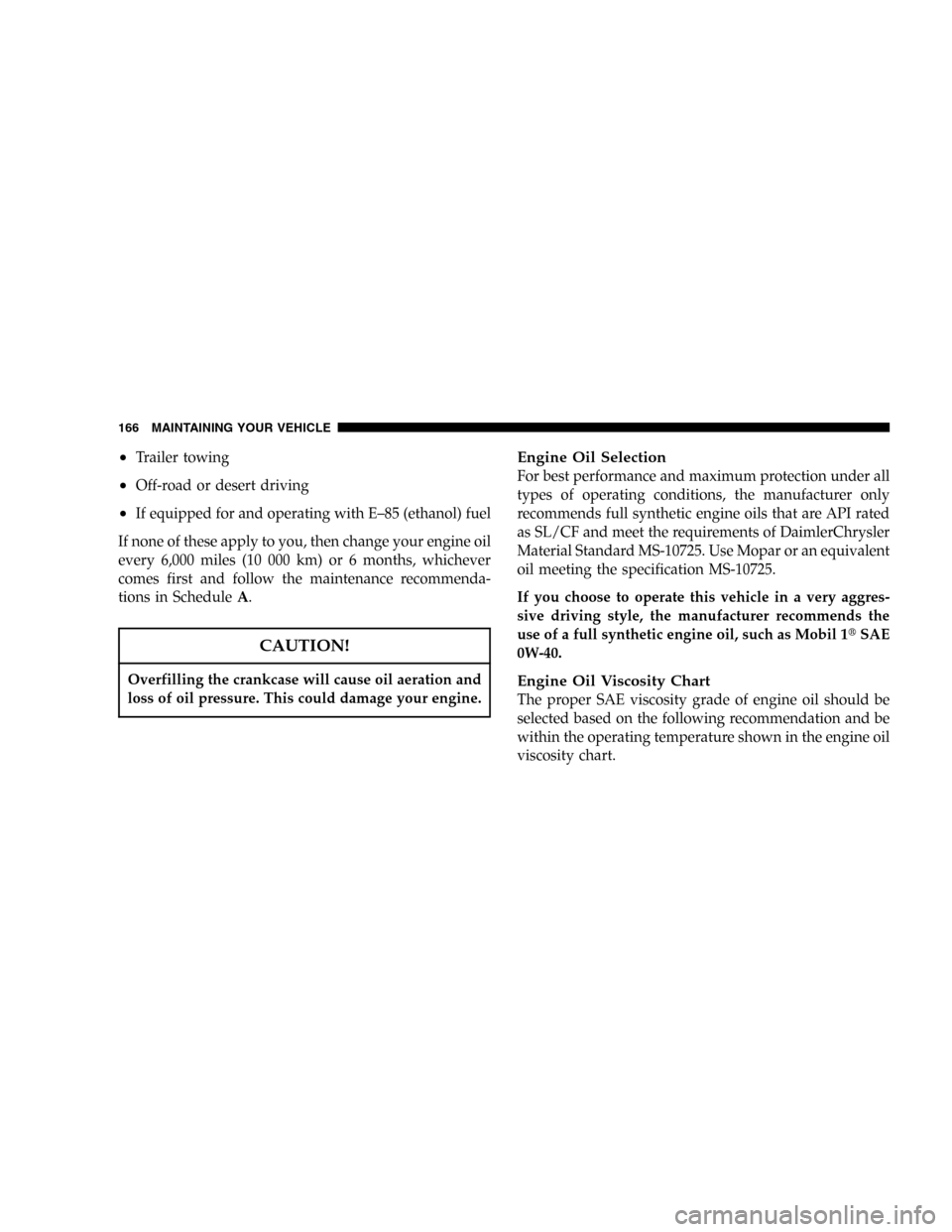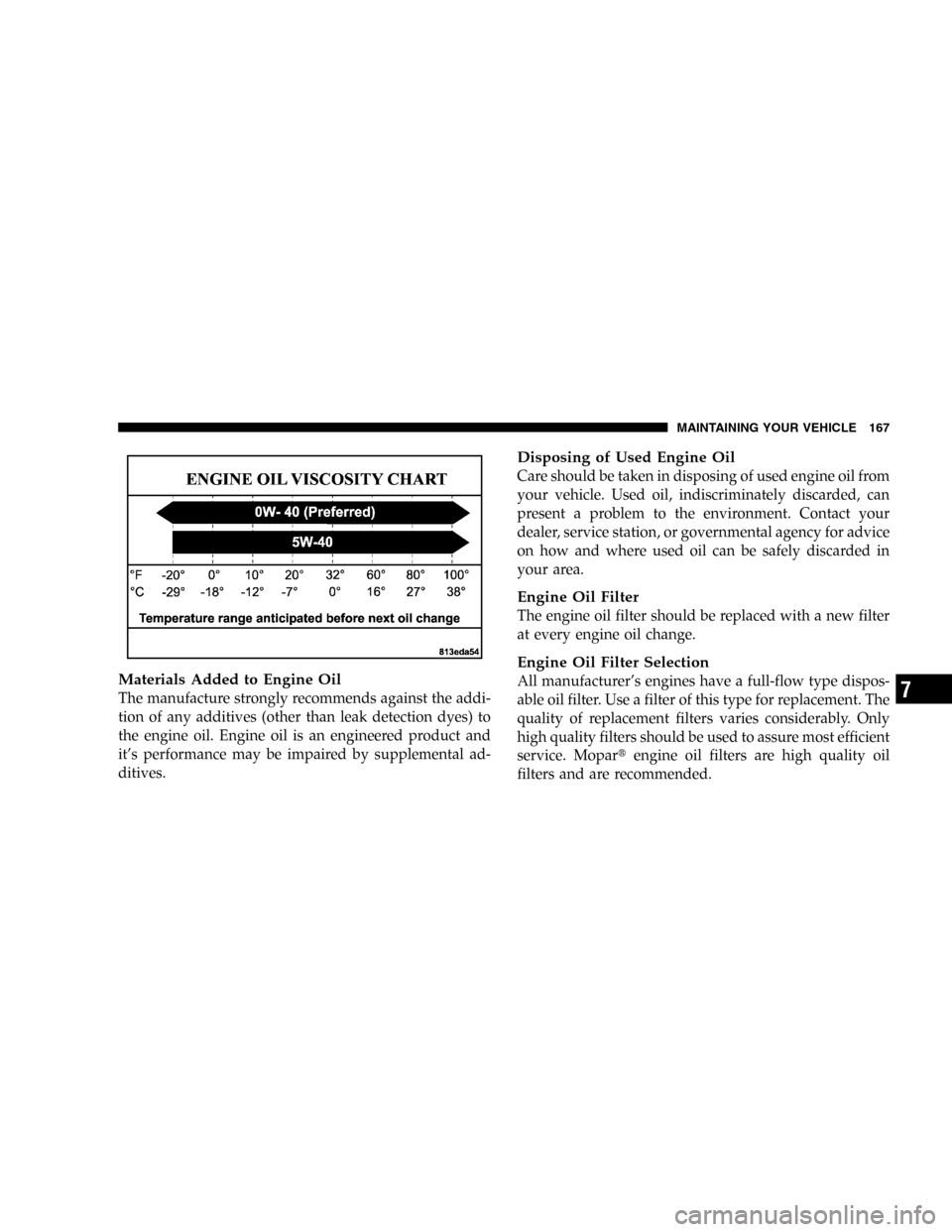Page 166 of 264

•Trailer towing
•Off-road or desert driving
•If equipped for and operating with E–85 (ethanol) fuel
If none of these apply to you, then change your engine oil
every 6,000 miles (10 000 km) or 6 months, whichever
comes first and follow the maintenance recommenda-
tions in ScheduleA.
CAUTION!
Overfilling the crankcase will cause oil aeration and
loss of oil pressure. This could damage your engine.
Engine Oil Selection
For best performance and maximum protection under all
types of operating conditions, the manufacturer only
recommends full synthetic engine oils that are API rated
as SL/CF and meet the requirements of DaimlerChrysler
Material Standard MS-10725. Use Mopar or an equivalent
oil meeting the specification MS-10725.
If you choose to operate this vehicle in a very aggres-
sive driving style, the manufacturer recommends the
use of a full synthetic engine oil, such as Mobil 1�SAE
0W-40.
Engine Oil Viscosity Chart
The proper SAE viscosity grade of engine oil should be
selected based on the following recommendation and be
within the operating temperature shown in the engine oil
viscosity chart.
166 MAINTAINING YOUR VEHICLE
Page 167 of 264

Materials Added to Engine Oil
The manufacture strongly recommends against the addi-
tion of any additives (other than leak detection dyes) to
the engine oil. Engine oil is an engineered product and
it’s performance may be impaired by supplemental ad-
ditives.
Disposing of Used Engine Oil
Care should be taken in disposing of used engine oil from
your vehicle. Used oil, indiscriminately discarded, can
present a problem to the environment. Contact your
dealer, service station, or governmental agency for advice
on how and where used oil can be safely discarded in
your area.
Engine Oil Filter
The engine oil filter should be replaced with a new filter
at every engine oil change.
Engine Oil Filter Selection
All manufacturer’s engines have a full-flow type dispos-
able oil filter. Use a filter of this type for replacement. The
quality of replacement filters varies considerably. Only
high quality filters should be used to assure most efficient
service. Mopar�engine oil filters are high quality oil
filters and are recommended.
MAINTAINING YOUR VEHICLE 167
7
Page 170 of 264

To minimize the possibility of catalytic converter dam-
age:
•Do not shut off the engine or interrupt the ignition
when the transmission is in gear and the vehicle is in
motion.
•Do not try to start the engine by pushing or towing the
vehicle.
•Do not idle the engine with any spark plug wires
disconnected for prolonged period.
Ignition Wiring System and Ignition Timing
The ignition cables should be kept clean and properly
connected. Terminals should be fully seated. Do not
remove the nipple assemblies from the coil towers unless
the nipples are damaged or cable testing shows high
resistance or broken insulation. Refer to the Service
Manual for the proper procedure to be followed for
checking ignition cable resistance. Cracked, damaged, or
faulty cables should be replaced.
Because of the plastic body shell on your Viper, ignition
cables should be replaced with the specially designed RFI
cables available at your dealer.
Ignition timing cannot be set on this vehicle.
170 MAINTAINING YOUR VEHICLE
Page 182 of 264

•Rubber bushings
•Starter bearing
•Throttle control cable
•Water pump bearings
Windshield Washers
The fluid reservoir in the right side engine compartment
should be checked for fluid level at regular intervals. Fill
the reservoir with windshield antifreeze (not radiator
antifreeze).
Exhaust System
The best protection against carbon monoxide entry into
the vehicle body is a properly maintained engine exhaust
system.
If you notice a change in the sound of the exhaust system;
or if exhaust fumes can be detected inside the vehicle; or
when the underside or side of the vehicle is damaged;have a competent mechanic inspect the complete exhaust
system and adjacent body areas for broken, damaged,
deteriorated, or mispositioned parts. Open seams or
loose connections could permit exhaust fumes to seep
into the passenger compartment. In addition, inspect the
exhaust system each time the vehicle is raised for lubri-
cation or oil change. Replace as required.
WARNING!
Exhaust gases can injure or kill. They contain carbon
monoxide which is colorless and odorless. Breathing
it can make you unconscious and can eventually
poison you.
182 MAINTAINING YOUR VEHICLE
Page 190 of 264
servicing. It is mandatory to replace all clamps that have
been loosened or removed during service.
NOTE:Inspection of brake hoses should be done when-
ever the brake system is serviced and at every engine oil
change. If there is any evidence of cracking, scuffing, or
worn spots, the hose should be replaced immediately!
Eventual deterioration of the hose can take place with
possible burst failure.Brake and Clutch Fluid
These fluids will tend to absorb moisture from the
atmosphere over a period of time. If the fluid becomes
contaminated with water, brake or clutch performance
will deteriorate. The brake and clutch fluid must be
changed every two years.
Clutch Fluid Reservoir
190 MAINTAINING YOUR VEHICLE
Page 212 of 264

Headlight Aiming
The headlights on your new Viper were aimed at the
factory. The factory setting was made at a no load setting.
A great increase in weight will change the aiming and it
may be necessary to readjust the headlights if you
typically carry an excessive amount of weight in the
trunk or otherwise suspect misalignment.
Aiming Check
Each headlight assembly can be adjusted up and down
only. No left to right adjustment is necessary. To check,
proceed as follows:
1. Fill the fuel tank and park the vehicle on level ground.
A driveway is not normally level. If in doubt and you
have no way to check levelness, do not attempt to adjust
the headlights.
2.
Mark the position of the headlights on a wall prior to
loading the vehicle. Load the trunk with the items you
normally carry. Have someone sit in the driver’s seat who is
about the same weight as the person who drives the vehicle.
3. Push down on the front and rear of the vehicle several
times to make sure that the suspension has settled.
4. Then readjust the headlights to the original position.
NOTE:If any further adjustments are necessary, contact
your dealership.
FLUIDS AND CAPACITIESU.S. Metric
Fuel (approximate)
8.3 Liter Engine (Premium 91
Octane)18 gal-
lons68 liters
Engine Oil-With Filter
8.3 Liter Engines (0W-40) 10 qts. 9.5 Liters
Cooling System *
8.3 Liter Engines* (Mopar�
Antifreeze/Coolant 5 Year/
102,000 Mile Formula)16 qts. 15 Liters
* Includes heater and coolant recovery bottle filled to
MAX level.
212 MAINTAINING YOUR VEHICLE
Page 213 of 264
RECOMMENDED FLUIDS, LUBRICANTS AND
GENUINE PARTS
Engine
Component Fluid, Lubricant, or Genuine Part
Engine Coolant Mopar�Antifreeze/Coolant 5 Year/102,000 Mile Formula HOAT (Hybrid Or-
ganic Additive Technology)
Engine Oil Use API rated SL/CF full synthetic engine oil. SAE 0W-40 is recommended.
Refer to the engine oil viscosity chart for the correct SAE grade meeting
DaimlerChrysler Material Standard MS-10725.
Engine Oil Filter Mopar�Engine Oil Filter
Spark Plugs Refer to the Vehicle Emission Control Information label in the engine compart-
ment.
Fuel Selection Premium Unleaded 91 Octane Only or higher
MAINTAINING YOUR VEHICLE 213
7
Page 219 of 264

•Taxi, police, or delivery service (commercial ser-
vice).�
•Off-road or desert operation.
•If equipped for and operating with E-85 (ethanol)
fuel.
NOTE:IfANYof these apply to you then change your
engine oil every 3,000 miles (5,000 km) or 3 months,
whichever comes first and follow schedule B of the
“Maintenance Schedules”section of this manual.
NOTE:IfANYof these apply to you then flush and
replace the engine coolant every 102,000 miles (164,000
km) or 60 months, whichever comes first, and follow
schedule B of the�Maintenance Schedules�section of this
manual.
NOTE:Most vehicles are operated under the conditions
listed for Schedule�B�.Second is Schedule“A”. It is for vehicles that are not
operated under any of the conditions listed under Sched-
ule�B�.
Use the schedule that best describes your driving condi-
tions. Where time and mileage are listed, follow the
interval that occurs first.
NOTE: Under no circumstances should oil change
intervals exceed 6 months or 6,000 miles, whichever
comes first.
CAUTION!
Failure to perform the required maintenance items
may result in damage to the vehicle.
MAINTENANCE SCHEDULES 219
8
M
A
I
N
T
E
N
A
N
C
E
S
C
H
E
D
U
L
E
S